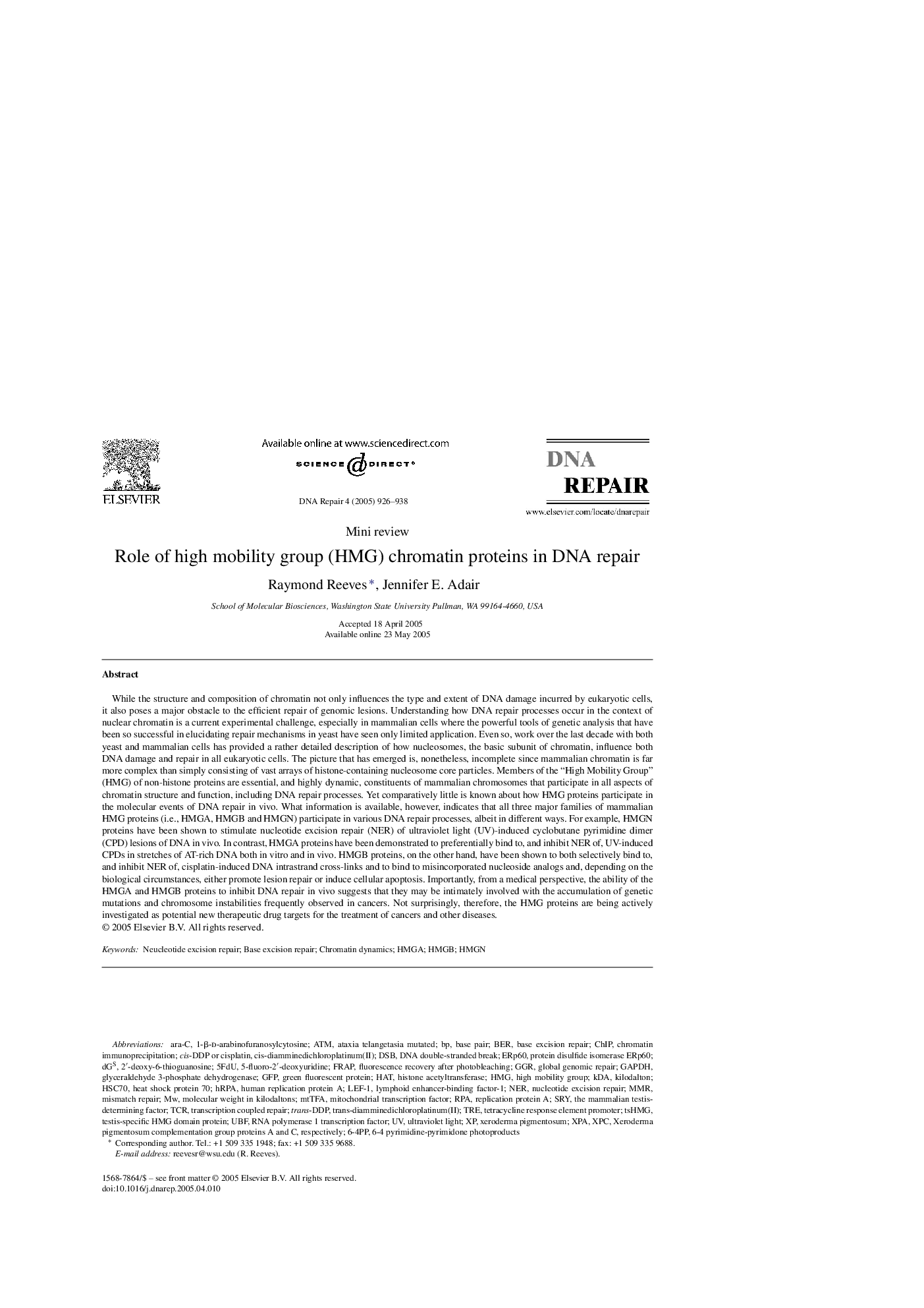| کد مقاله | کد نشریه | سال انتشار | مقاله انگلیسی | نسخه تمام متن |
|---|---|---|---|---|
| 10823650 | 1061914 | 2005 | 13 صفحه PDF | دانلود رایگان |
عنوان انگلیسی مقاله ISI
Role of high mobility group (HMG) chromatin proteins in DNA repair
دانلود مقاله + سفارش ترجمه
دانلود مقاله ISI انگلیسی
رایگان برای ایرانیان
کلمات کلیدی
DSBHuman replication protein Atrans-DDPtrans-diamminedichloroplatinum(II)UBFLEF-16-4PPHMGBHMGADGsHmgRPAMMRBERkDaTCrHsc70GAPDHkiloDaltonGFPFRAP1-β-d-arabinofuranosylcytosine - 1-β-D-arabinofuranosylcytosine5-fluoro-2′-deoxyuridine - 5-fluoro-2'-deoxyuridinecis-diamminedichloroplatinum(II) - cis-diamminedichloroplatinum (II)NER - DOWNmtTFA - MTTFxeroderma pigmentosum - pigmentosum xerodermaAra-C - آرا- Cchromatin immunoprecipitation - ایمن سازی کروماتینGGR - بارnucleotide excision repair - تعمیر مجدد نوکلئوتیدیmismatch repair - تعمیر ناسازگاریbase excision repair - تعمیر پایه پایهGlobal genomic repair - تعمیر ژنوم جهانیreplication protein A - تلقیح پروتئین Abase pair - جفت پایهATM - خودپردازchromatin dynamics - دینامیک کروماتینtranscription coupled repair - رونویسی همراه با تعمیرTRE - سهSry - سوریHMGN - ششMitochondrial transcription factor - فاکتور رونویسی میتوکندریfluorescence recovery after photobleaching - فلوئورسانس پس از فوتوبلاسیکultraviolet light - نور ماوراءبنفش یا نور فرابنفشHistone acetyltransferase - هیستون استیل ترانسفرازheat shock protein 70 - پروتئین شوک حرارت 70green fluorescent protein - پروتئین فلورسنت سبزhRPA - پشتهCHiP - چیپHAT - کلاهhigh mobility group - گروه تحرک بالاglyceraldehyde 3-phosphate dehydrogenase - گلیسرولیدید 3-فسفات دهیدروژناز
موضوعات مرتبط
علوم زیستی و بیوفناوری
بیوشیمی، ژنتیک و زیست شناسی مولکولی
زیست شیمی
پیش نمایش صفحه اول مقاله

چکیده انگلیسی
While the structure and composition of chromatin not only influences the type and extent of DNA damage incurred by eukaryotic cells, it also poses a major obstacle to the efficient repair of genomic lesions. Understanding how DNA repair processes occur in the context of nuclear chromatin is a current experimental challenge, especially in mammalian cells where the powerful tools of genetic analysis that have been so successful in elucidating repair mechanisms in yeast have seen only limited application. Even so, work over the last decade with both yeast and mammalian cells has provided a rather detailed description of how nucleosomes, the basic subunit of chromatin, influence both DNA damage and repair in all eukaryotic cells. The picture that has emerged is, nonetheless, incomplete since mammalian chromatin is far more complex than simply consisting of vast arrays of histone-containing nucleosome core particles. Members of the “High Mobility Group” (HMG) of non-histone proteins are essential, and highly dynamic, constituents of mammalian chromosomes that participate in all aspects of chromatin structure and function, including DNA repair processes. Yet comparatively little is known about how HMG proteins participate in the molecular events of DNA repair in vivo. What information is available, however, indicates that all three major families of mammalian HMG proteins (i.e., HMGA, HMGB and HMGN) participate in various DNA repair processes, albeit in different ways. For example, HMGN proteins have been shown to stimulate nucleotide excision repair (NER) of ultraviolet light (UV)-induced cyclobutane pyrimidine dimer (CPD) lesions of DNA in vivo. In contrast, HMGA proteins have been demonstrated to preferentially bind to, and inhibit NER of, UV-induced CPDs in stretches of AT-rich DNA both in vitro and in vivo. HMGB proteins, on the other hand, have been shown to both selectively bind to, and inhibit NER of, cisplatin-induced DNA intrastrand cross-links and to bind to misincorporated nucleoside analogs and, depending on the biological circumstances, either promote lesion repair or induce cellular apoptosis. Importantly, from a medical perspective, the ability of the HMGA and HMGB proteins to inhibit DNA repair in vivo suggests that they may be intimately involved with the accumulation of genetic mutations and chromosome instabilities frequently observed in cancers. Not surprisingly, therefore, the HMG proteins are being actively investigated as potential new therapeutic drug targets for the treatment of cancers and other diseases.
ناشر
Database: Elsevier - ScienceDirect (ساینس دایرکت)
Journal: DNA Repair - Volume 4, Issue 8, 28 July 2005, Pages 926-938
Journal: DNA Repair - Volume 4, Issue 8, 28 July 2005, Pages 926-938
نویسندگان
Raymond Reeves, Jennifer E. Adair,